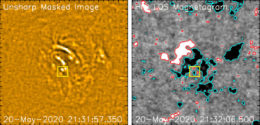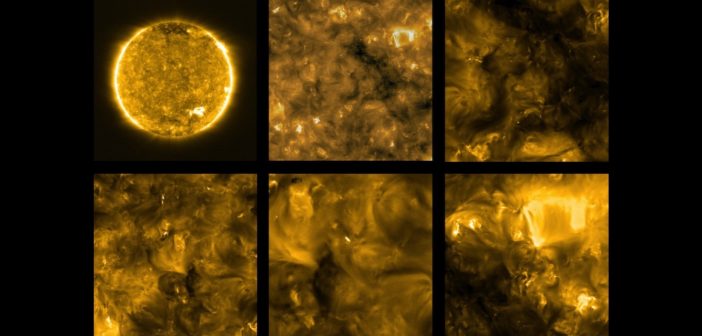You’ve heard of sunspots, but how about Sun dots? A recent solar mission has snapped photos of tiny, bright dots on the Sun, and astronomers are contemplating their cause.
Something New on the Sun

An illustration of the dates of major orbital milestones in the Solar Orbiter mission. Click to enlarge. [ESA-S.Poletti]
Today’s article dives into some of the exquisite data from Solar Orbiter to investigate an even smaller-scale phenomenon: the fleeting appearance of dozens of tiny, bright dots.
Seeing Spots
A team led by Sanjiv Tiwari (Lockheed Martin Solar and Astrophysics Laboratory and Bay Area Environmental Research Institute) began their investigation of these dots with Solar Orbiter observations from 20 May 2020, when the Sun’s dynamic activity cycle was at a simmer. Using images from the Extreme Ultraviolet Imager, Tiwari and collaborators analyzed a region where loops and strands of magnetic flux were poking through the Sun’s surface. The images revealed tiny spots faintly visible against the bright background of hot plasma.

Solar Orbiter Extreme Ultraviolet Imager (left) and post-processing image (right) of the dots, which are indicated by the yellow boxes. [Adapted from Tiwari et al. 2022]
Making a Magnetic Connection

A Solar Dynamics Observatory extreme-ultraviolet image with an unsharp mask applied (left) and the line-of-sight magnetic field strength for the same region (right). The dot being studied is indicated by the yellow square. [Adapted from Tiwari et al. 2022]
So, what causes these dots? Using magnetohydrodynamic simulations, the team confirmed that most dots are associated with interacting magnetic field lines and potentially occur when field lines snaking out from beneath the solar surface connect with those already above the surface. However, a smaller number of dots were free of tangled magnetic field lines, and they may have instead been formed by shock waves moving through the region.
With Solar Orbiter making its way closer to the Sun over the next few years, we should be able to get a better view of these dots and better understand their origins. Who knows what kind of dots we’ll be able to spot then!
Citation
“SolO/EUI Observations of Ubiquitous Fine-scale Bright Dots in an Emerging Flux Region: Comparison with a Bifrost MHD Simulation,” Sanjiv K. Tiwari et al 2022 ApJ 929 103. doi:10.3847/1538-4357/ac5d46

